Medical Surgical Nursing 2: COPD Care Plan and Nursing Diagnoses
VerifiedAdded on 2023/01/16
|11
|3193
|47
Report
AI Summary
This report presents a comprehensive care plan for a patient with an infective exacerbation of Chronic Obstructive Pulmonary Disease (COPD). It addresses key considerations for care plan preparation, including emotional support, breathing exercises, nutrition, and exercise. The report details three types of nursing assessments: initial, shift, and focused assessments, and evaluation assessment. It identifies three priority nursing diagnoses: ineffective breathing pattern, impaired gas exchange, and ineffective airway clearance. Additionally, the report outlines specific education for COPD patients post-discharge, including lifestyle changes, smoking cessation, symptom awareness, nutritional guidance, and advance directives. Finally, it discusses the involvement of allied health team members in the patient's care during admission and preparation for discharge, emphasizing a multidisciplinary approach to COPD management. This report is a response to the NUR250 Medical Surgical Nursing 2 Assessment 1 assignment, demonstrating the application of the clinical reasoning cycle in nursing care planning.
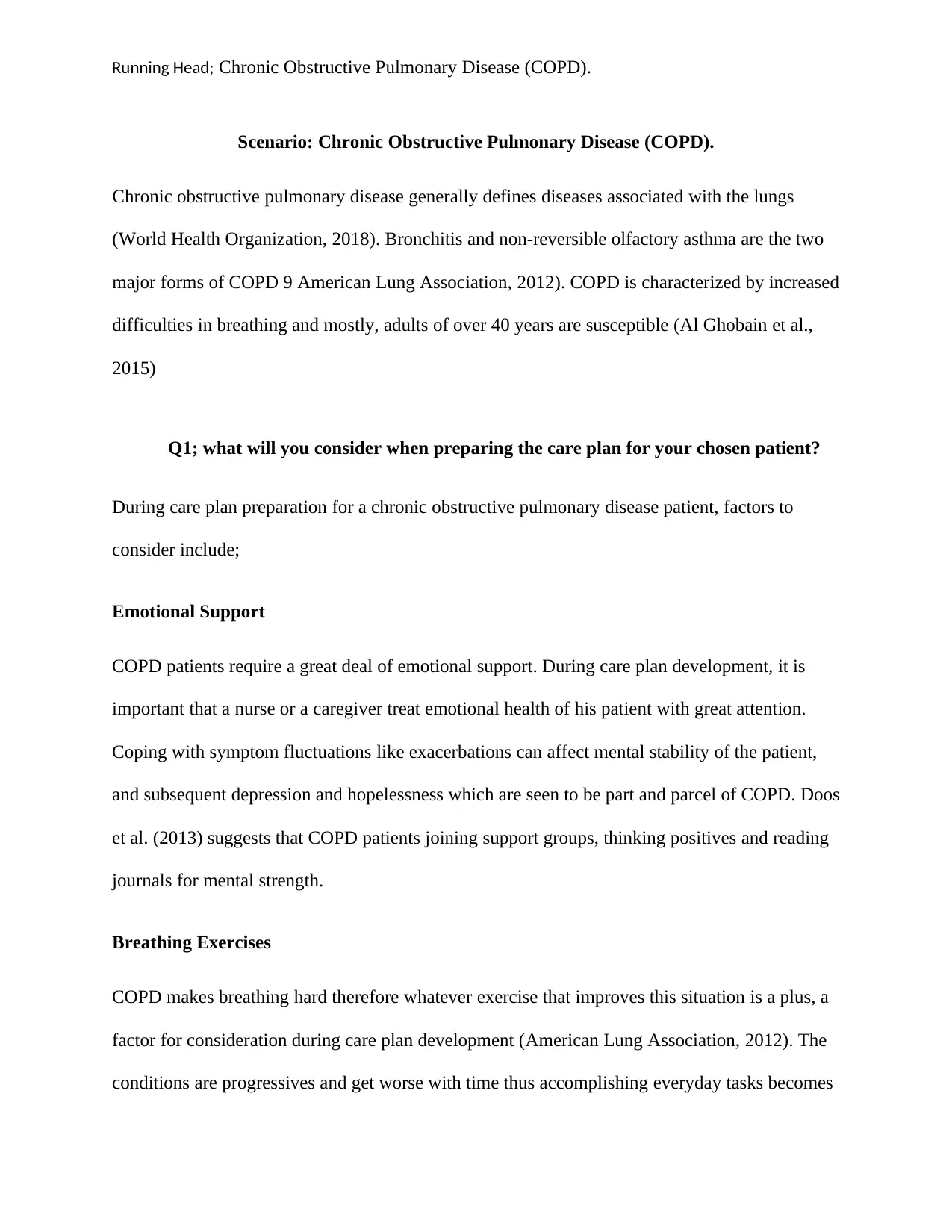
Running Head; Chronic Obstructive Pulmonary Disease (COPD).
Scenario: Chronic Obstructive Pulmonary Disease (COPD).
Chronic obstructive pulmonary disease generally defines diseases associated with the lungs
(World Health Organization, 2018). Bronchitis and non-reversible olfactory asthma are the two
major forms of COPD 9 American Lung Association, 2012). COPD is characterized by increased
difficulties in breathing and mostly, adults of over 40 years are susceptible (Al Ghobain et al.,
2015)
Q1; what will you consider when preparing the care plan for your chosen patient?
During care plan preparation for a chronic obstructive pulmonary disease patient, factors to
consider include;
Emotional Support
COPD patients require a great deal of emotional support. During care plan development, it is
important that a nurse or a caregiver treat emotional health of his patient with great attention.
Coping with symptom fluctuations like exacerbations can affect mental stability of the patient,
and subsequent depression and hopelessness which are seen to be part and parcel of COPD. Doos
et al. (2013) suggests that COPD patients joining support groups, thinking positives and reading
journals for mental strength.
Breathing Exercises
COPD makes breathing hard therefore whatever exercise that improves this situation is a plus, a
factor for consideration during care plan development (American Lung Association, 2012). The
conditions are progressives and get worse with time thus accomplishing everyday tasks becomes
Scenario: Chronic Obstructive Pulmonary Disease (COPD).
Chronic obstructive pulmonary disease generally defines diseases associated with the lungs
(World Health Organization, 2018). Bronchitis and non-reversible olfactory asthma are the two
major forms of COPD 9 American Lung Association, 2012). COPD is characterized by increased
difficulties in breathing and mostly, adults of over 40 years are susceptible (Al Ghobain et al.,
2015)
Q1; what will you consider when preparing the care plan for your chosen patient?
During care plan preparation for a chronic obstructive pulmonary disease patient, factors to
consider include;
Emotional Support
COPD patients require a great deal of emotional support. During care plan development, it is
important that a nurse or a caregiver treat emotional health of his patient with great attention.
Coping with symptom fluctuations like exacerbations can affect mental stability of the patient,
and subsequent depression and hopelessness which are seen to be part and parcel of COPD. Doos
et al. (2013) suggests that COPD patients joining support groups, thinking positives and reading
journals for mental strength.
Breathing Exercises
COPD makes breathing hard therefore whatever exercise that improves this situation is a plus, a
factor for consideration during care plan development (American Lung Association, 2012). The
conditions are progressives and get worse with time thus accomplishing everyday tasks becomes
Paraphrase This Document
Need a fresh take? Get an instant paraphrase of this document with our AI Paraphraser
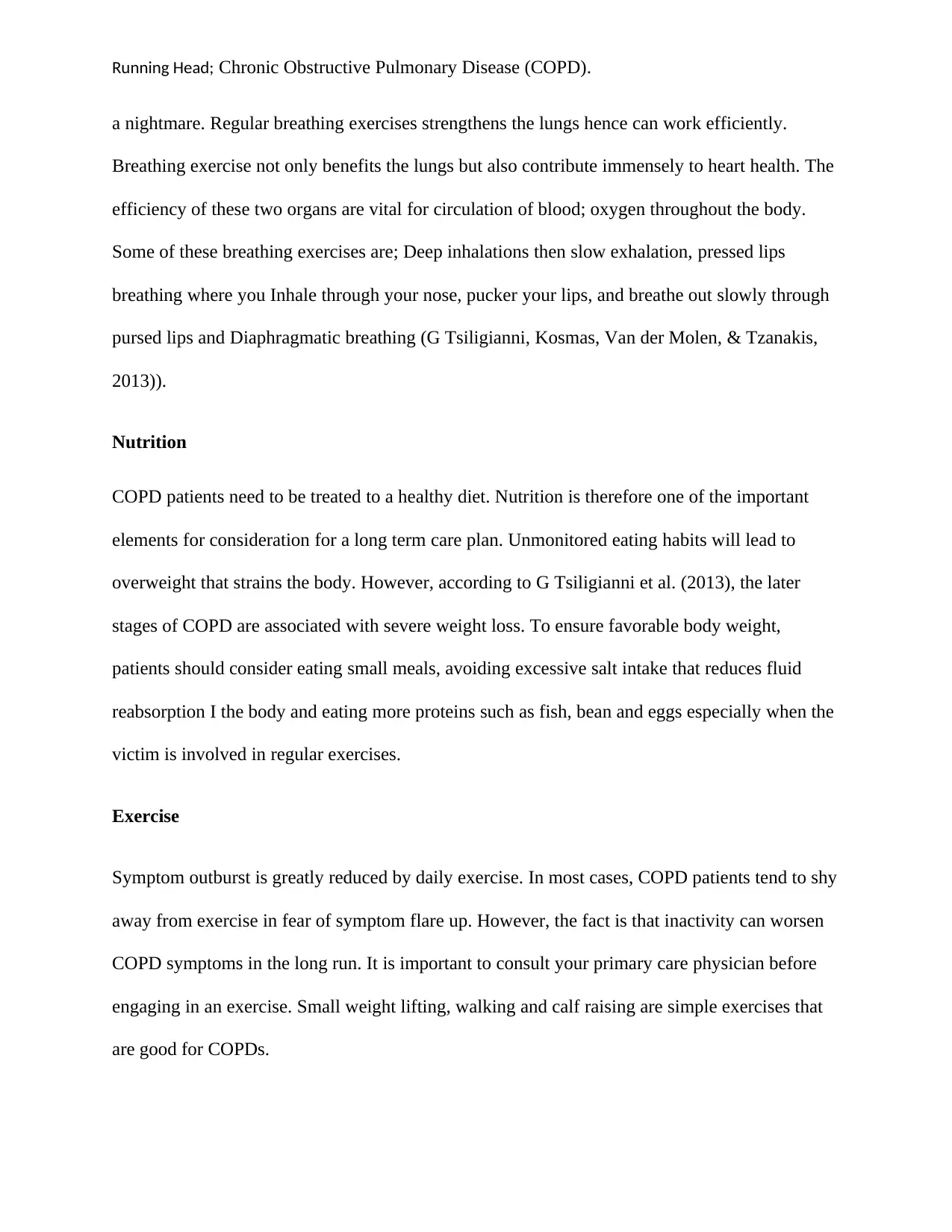
Running Head; Chronic Obstructive Pulmonary Disease (COPD).
a nightmare. Regular breathing exercises strengthens the lungs hence can work efficiently.
Breathing exercise not only benefits the lungs but also contribute immensely to heart health. The
efficiency of these two organs are vital for circulation of blood; oxygen throughout the body.
Some of these breathing exercises are; Deep inhalations then slow exhalation, pressed lips
breathing where you Inhale through your nose, pucker your lips, and breathe out slowly through
pursed lips and Diaphragmatic breathing (G Tsiligianni, Kosmas, Van der Molen, & Tzanakis,
2013)).
Nutrition
COPD patients need to be treated to a healthy diet. Nutrition is therefore one of the important
elements for consideration for a long term care plan. Unmonitored eating habits will lead to
overweight that strains the body. However, according to G Tsiligianni et al. (2013), the later
stages of COPD are associated with severe weight loss. To ensure favorable body weight,
patients should consider eating small meals, avoiding excessive salt intake that reduces fluid
reabsorption I the body and eating more proteins such as fish, bean and eggs especially when the
victim is involved in regular exercises.
Exercise
Symptom outburst is greatly reduced by daily exercise. In most cases, COPD patients tend to shy
away from exercise in fear of symptom flare up. However, the fact is that inactivity can worsen
COPD symptoms in the long run. It is important to consult your primary care physician before
engaging in an exercise. Small weight lifting, walking and calf raising are simple exercises that
are good for COPDs.
a nightmare. Regular breathing exercises strengthens the lungs hence can work efficiently.
Breathing exercise not only benefits the lungs but also contribute immensely to heart health. The
efficiency of these two organs are vital for circulation of blood; oxygen throughout the body.
Some of these breathing exercises are; Deep inhalations then slow exhalation, pressed lips
breathing where you Inhale through your nose, pucker your lips, and breathe out slowly through
pursed lips and Diaphragmatic breathing (G Tsiligianni, Kosmas, Van der Molen, & Tzanakis,
2013)).
Nutrition
COPD patients need to be treated to a healthy diet. Nutrition is therefore one of the important
elements for consideration for a long term care plan. Unmonitored eating habits will lead to
overweight that strains the body. However, according to G Tsiligianni et al. (2013), the later
stages of COPD are associated with severe weight loss. To ensure favorable body weight,
patients should consider eating small meals, avoiding excessive salt intake that reduces fluid
reabsorption I the body and eating more proteins such as fish, bean and eggs especially when the
victim is involved in regular exercises.
Exercise
Symptom outburst is greatly reduced by daily exercise. In most cases, COPD patients tend to shy
away from exercise in fear of symptom flare up. However, the fact is that inactivity can worsen
COPD symptoms in the long run. It is important to consult your primary care physician before
engaging in an exercise. Small weight lifting, walking and calf raising are simple exercises that
are good for COPDs.

Running Head; Chronic Obstructive Pulmonary Disease (COPD).
Question 2: Three types of Nursing Assessments
Initial Assessment; this is also known as admission assessment. It involves detailed information
such as general appearance and the history of the patient, physical examinations and signs. This
assessment is done by a nurse together with a caregiver on arrival not later than 24hours. The
information of the patient must be ensured. Other assessments such as body weight, blood sugar
level and height are also done.
Shift Assessment: incisive assessment aims at establishment of information when the condition
of the patient changes. From this information, a care plan is developed. On the patients care plan,
the shifts in initial assessment are documented while any other checkup is recorded in the
progress notes. Decision on the kind of assessment required is based on clinical interpretations
and inferences. The examination starts with assessment of the look of the patient such us pale or
normal, active or lethargic, movement and posture among others.
Focused assessment: Assesses target body parts or systems that are related to the problem in
question. It can sometimes depend on the patient’s present condition. The assessment can target
more than one system of the body. Clinical judgment of the nurse is key to ascertain which
components of a focused assessment are relevant for their patient
Evaluation Assessment: In this phase, information collected is complete, precise and properly
recorded. The nurse, using his critical thinking and problem solving prowess should be able to
make clinical judgment and develop a care plan for the patient. The nurse must be in a position
of taking an appropriate action in case an abnormal finding. If any abnormal findings are
identified, the nurse must ensure that appropriate action is taken.
Question 2: Three types of Nursing Assessments
Initial Assessment; this is also known as admission assessment. It involves detailed information
such as general appearance and the history of the patient, physical examinations and signs. This
assessment is done by a nurse together with a caregiver on arrival not later than 24hours. The
information of the patient must be ensured. Other assessments such as body weight, blood sugar
level and height are also done.
Shift Assessment: incisive assessment aims at establishment of information when the condition
of the patient changes. From this information, a care plan is developed. On the patients care plan,
the shifts in initial assessment are documented while any other checkup is recorded in the
progress notes. Decision on the kind of assessment required is based on clinical interpretations
and inferences. The examination starts with assessment of the look of the patient such us pale or
normal, active or lethargic, movement and posture among others.
Focused assessment: Assesses target body parts or systems that are related to the problem in
question. It can sometimes depend on the patient’s present condition. The assessment can target
more than one system of the body. Clinical judgment of the nurse is key to ascertain which
components of a focused assessment are relevant for their patient
Evaluation Assessment: In this phase, information collected is complete, precise and properly
recorded. The nurse, using his critical thinking and problem solving prowess should be able to
make clinical judgment and develop a care plan for the patient. The nurse must be in a position
of taking an appropriate action in case an abnormal finding. If any abnormal findings are
identified, the nurse must ensure that appropriate action is taken.
⊘ This is a preview!⊘
Do you want full access?
Subscribe today to unlock all pages.

Trusted by 1+ million students worldwide
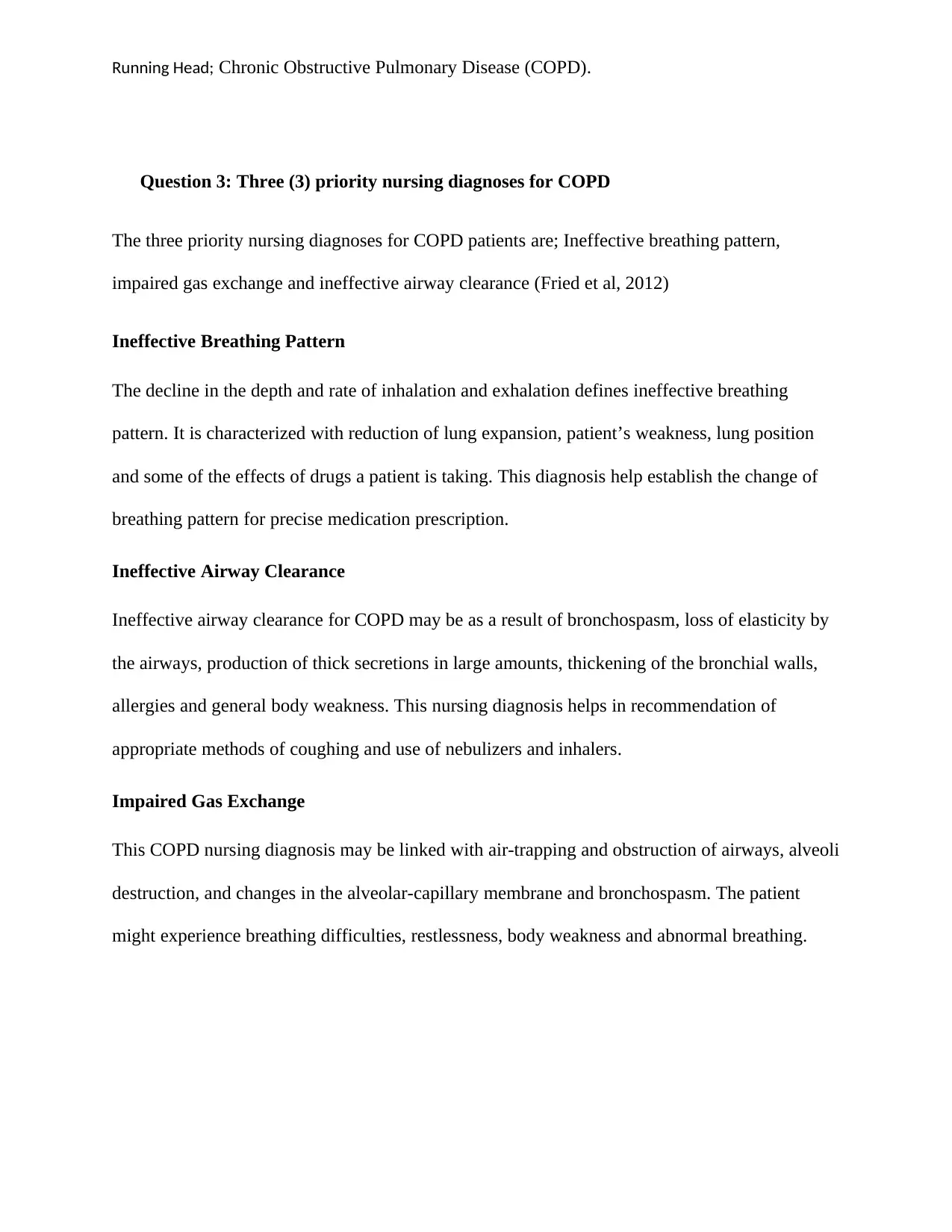
Running Head; Chronic Obstructive Pulmonary Disease (COPD).
Question 3: Three (3) priority nursing diagnoses for COPD
The three priority nursing diagnoses for COPD patients are; Ineffective breathing pattern,
impaired gas exchange and ineffective airway clearance (Fried et al, 2012)
Ineffective Breathing Pattern
The decline in the depth and rate of inhalation and exhalation defines ineffective breathing
pattern. It is characterized with reduction of lung expansion, patient’s weakness, lung position
and some of the effects of drugs a patient is taking. This diagnosis help establish the change of
breathing pattern for precise medication prescription.
Ineffective Airway Clearance
Ineffective airway clearance for COPD may be as a result of bronchospasm, loss of elasticity by
the airways, production of thick secretions in large amounts, thickening of the bronchial walls,
allergies and general body weakness. This nursing diagnosis helps in recommendation of
appropriate methods of coughing and use of nebulizers and inhalers.
Impaired Gas Exchange
This COPD nursing diagnosis may be linked with air-trapping and obstruction of airways, alveoli
destruction, and changes in the alveolar-capillary membrane and bronchospasm. The patient
might experience breathing difficulties, restlessness, body weakness and abnormal breathing.
Question 3: Three (3) priority nursing diagnoses for COPD
The three priority nursing diagnoses for COPD patients are; Ineffective breathing pattern,
impaired gas exchange and ineffective airway clearance (Fried et al, 2012)
Ineffective Breathing Pattern
The decline in the depth and rate of inhalation and exhalation defines ineffective breathing
pattern. It is characterized with reduction of lung expansion, patient’s weakness, lung position
and some of the effects of drugs a patient is taking. This diagnosis help establish the change of
breathing pattern for precise medication prescription.
Ineffective Airway Clearance
Ineffective airway clearance for COPD may be as a result of bronchospasm, loss of elasticity by
the airways, production of thick secretions in large amounts, thickening of the bronchial walls,
allergies and general body weakness. This nursing diagnosis helps in recommendation of
appropriate methods of coughing and use of nebulizers and inhalers.
Impaired Gas Exchange
This COPD nursing diagnosis may be linked with air-trapping and obstruction of airways, alveoli
destruction, and changes in the alveolar-capillary membrane and bronchospasm. The patient
might experience breathing difficulties, restlessness, body weakness and abnormal breathing.
Paraphrase This Document
Need a fresh take? Get an instant paraphrase of this document with our AI Paraphraser
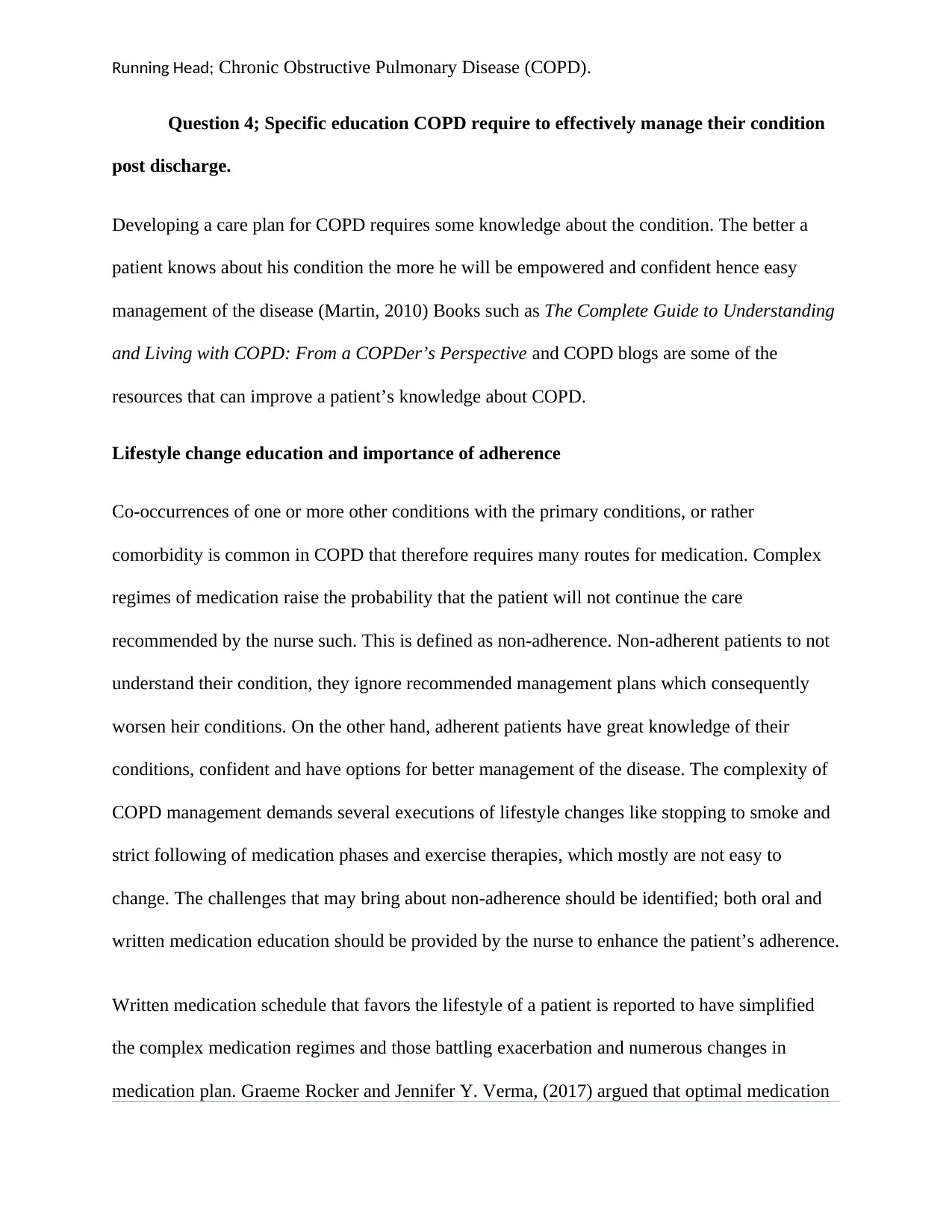
Running Head; Chronic Obstructive Pulmonary Disease (COPD).
Question 4; Specific education COPD require to effectively manage their condition
post discharge.
Developing a care plan for COPD requires some knowledge about the condition. The better a
patient knows about his condition the more he will be empowered and confident hence easy
management of the disease (Martin, 2010) Books such as The Complete Guide to Understanding
and Living with COPD: From a COPDer’s Perspective and COPD blogs are some of the
resources that can improve a patient’s knowledge about COPD.
Lifestyle change education and importance of adherence
Co-occurrences of one or more other conditions with the primary conditions, or rather
comorbidity is common in COPD that therefore requires many routes for medication. Complex
regimes of medication raise the probability that the patient will not continue the care
recommended by the nurse such. This is defined as non-adherence. Non-adherent patients to not
understand their condition, they ignore recommended management plans which consequently
worsen heir conditions. On the other hand, adherent patients have great knowledge of their
conditions, confident and have options for better management of the disease. The complexity of
COPD management demands several executions of lifestyle changes like stopping to smoke and
strict following of medication phases and exercise therapies, which mostly are not easy to
change. The challenges that may bring about non-adherence should be identified; both oral and
written medication education should be provided by the nurse to enhance the patient’s adherence.
Written medication schedule that favors the lifestyle of a patient is reported to have simplified
the complex medication regimes and those battling exacerbation and numerous changes in
medication plan. Graeme Rocker and Jennifer Y. Verma, (2017) argued that optimal medication
Question 4; Specific education COPD require to effectively manage their condition
post discharge.
Developing a care plan for COPD requires some knowledge about the condition. The better a
patient knows about his condition the more he will be empowered and confident hence easy
management of the disease (Martin, 2010) Books such as The Complete Guide to Understanding
and Living with COPD: From a COPDer’s Perspective and COPD blogs are some of the
resources that can improve a patient’s knowledge about COPD.
Lifestyle change education and importance of adherence
Co-occurrences of one or more other conditions with the primary conditions, or rather
comorbidity is common in COPD that therefore requires many routes for medication. Complex
regimes of medication raise the probability that the patient will not continue the care
recommended by the nurse such. This is defined as non-adherence. Non-adherent patients to not
understand their condition, they ignore recommended management plans which consequently
worsen heir conditions. On the other hand, adherent patients have great knowledge of their
conditions, confident and have options for better management of the disease. The complexity of
COPD management demands several executions of lifestyle changes like stopping to smoke and
strict following of medication phases and exercise therapies, which mostly are not easy to
change. The challenges that may bring about non-adherence should be identified; both oral and
written medication education should be provided by the nurse to enhance the patient’s adherence.
Written medication schedule that favors the lifestyle of a patient is reported to have simplified
the complex medication regimes and those battling exacerbation and numerous changes in
medication plan. Graeme Rocker and Jennifer Y. Verma, (2017) argued that optimal medication
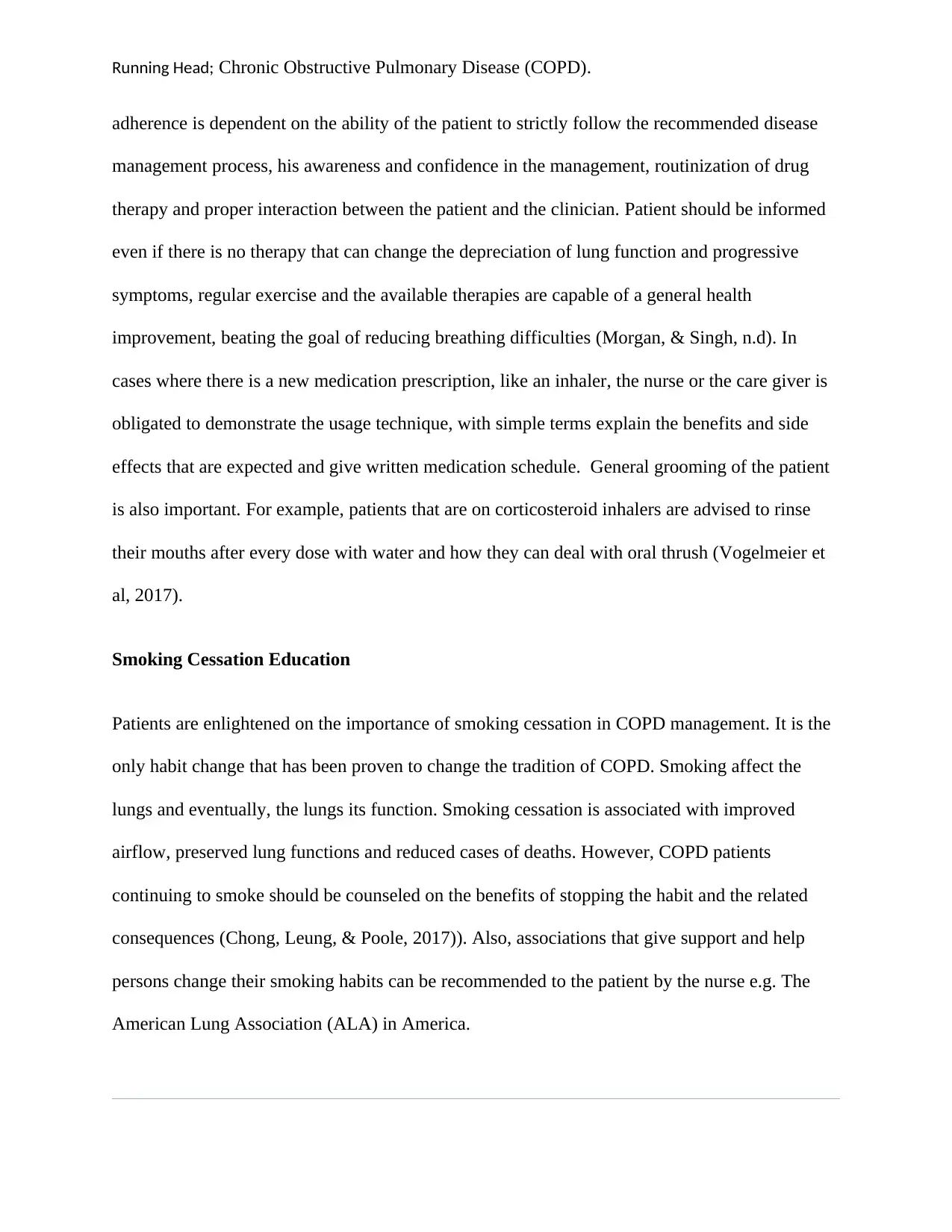
Running Head; Chronic Obstructive Pulmonary Disease (COPD).
adherence is dependent on the ability of the patient to strictly follow the recommended disease
management process, his awareness and confidence in the management, routinization of drug
therapy and proper interaction between the patient and the clinician. Patient should be informed
even if there is no therapy that can change the depreciation of lung function and progressive
symptoms, regular exercise and the available therapies are capable of a general health
improvement, beating the goal of reducing breathing difficulties (Morgan, & Singh, n.d). In
cases where there is a new medication prescription, like an inhaler, the nurse or the care giver is
obligated to demonstrate the usage technique, with simple terms explain the benefits and side
effects that are expected and give written medication schedule. General grooming of the patient
is also important. For example, patients that are on corticosteroid inhalers are advised to rinse
their mouths after every dose with water and how they can deal with oral thrush (Vogelmeier et
al, 2017).
Smoking Cessation Education
Patients are enlightened on the importance of smoking cessation in COPD management. It is the
only habit change that has been proven to change the tradition of COPD. Smoking affect the
lungs and eventually, the lungs its function. Smoking cessation is associated with improved
airflow, preserved lung functions and reduced cases of deaths. However, COPD patients
continuing to smoke should be counseled on the benefits of stopping the habit and the related
consequences (Chong, Leung, & Poole, 2017)). Also, associations that give support and help
persons change their smoking habits can be recommended to the patient by the nurse e.g. The
American Lung Association (ALA) in America.
adherence is dependent on the ability of the patient to strictly follow the recommended disease
management process, his awareness and confidence in the management, routinization of drug
therapy and proper interaction between the patient and the clinician. Patient should be informed
even if there is no therapy that can change the depreciation of lung function and progressive
symptoms, regular exercise and the available therapies are capable of a general health
improvement, beating the goal of reducing breathing difficulties (Morgan, & Singh, n.d). In
cases where there is a new medication prescription, like an inhaler, the nurse or the care giver is
obligated to demonstrate the usage technique, with simple terms explain the benefits and side
effects that are expected and give written medication schedule. General grooming of the patient
is also important. For example, patients that are on corticosteroid inhalers are advised to rinse
their mouths after every dose with water and how they can deal with oral thrush (Vogelmeier et
al, 2017).
Smoking Cessation Education
Patients are enlightened on the importance of smoking cessation in COPD management. It is the
only habit change that has been proven to change the tradition of COPD. Smoking affect the
lungs and eventually, the lungs its function. Smoking cessation is associated with improved
airflow, preserved lung functions and reduced cases of deaths. However, COPD patients
continuing to smoke should be counseled on the benefits of stopping the habit and the related
consequences (Chong, Leung, & Poole, 2017)). Also, associations that give support and help
persons change their smoking habits can be recommended to the patient by the nurse e.g. The
American Lung Association (ALA) in America.
⊘ This is a preview!⊘
Do you want full access?
Subscribe today to unlock all pages.

Trusted by 1+ million students worldwide
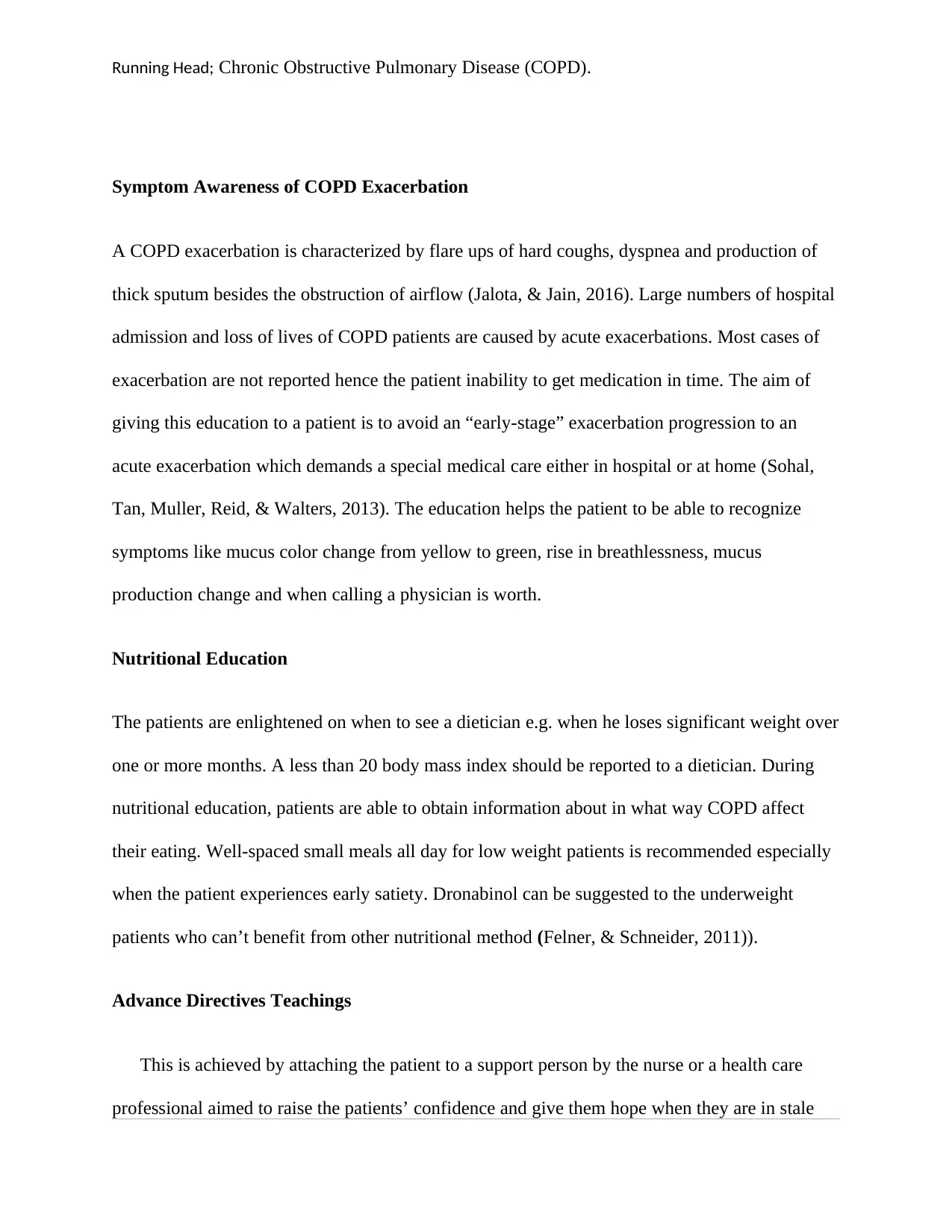
Running Head; Chronic Obstructive Pulmonary Disease (COPD).
Symptom Awareness of COPD Exacerbation
A COPD exacerbation is characterized by flare ups of hard coughs, dyspnea and production of
thick sputum besides the obstruction of airflow (Jalota, & Jain, 2016). Large numbers of hospital
admission and loss of lives of COPD patients are caused by acute exacerbations. Most cases of
exacerbation are not reported hence the patient inability to get medication in time. The aim of
giving this education to a patient is to avoid an “early-stage” exacerbation progression to an
acute exacerbation which demands a special medical care either in hospital or at home (Sohal,
Tan, Muller, Reid, & Walters, 2013). The education helps the patient to be able to recognize
symptoms like mucus color change from yellow to green, rise in breathlessness, mucus
production change and when calling a physician is worth.
Nutritional Education
The patients are enlightened on when to see a dietician e.g. when he loses significant weight over
one or more months. A less than 20 body mass index should be reported to a dietician. During
nutritional education, patients are able to obtain information about in what way COPD affect
their eating. Well-spaced small meals all day for low weight patients is recommended especially
when the patient experiences early satiety. Dronabinol can be suggested to the underweight
patients who can’t benefit from other nutritional method (Felner, & Schneider, 2011)).
Advance Directives Teachings
This is achieved by attaching the patient to a support person by the nurse or a health care
professional aimed to raise the patients’ confidence and give them hope when they are in stale
Symptom Awareness of COPD Exacerbation
A COPD exacerbation is characterized by flare ups of hard coughs, dyspnea and production of
thick sputum besides the obstruction of airflow (Jalota, & Jain, 2016). Large numbers of hospital
admission and loss of lives of COPD patients are caused by acute exacerbations. Most cases of
exacerbation are not reported hence the patient inability to get medication in time. The aim of
giving this education to a patient is to avoid an “early-stage” exacerbation progression to an
acute exacerbation which demands a special medical care either in hospital or at home (Sohal,
Tan, Muller, Reid, & Walters, 2013). The education helps the patient to be able to recognize
symptoms like mucus color change from yellow to green, rise in breathlessness, mucus
production change and when calling a physician is worth.
Nutritional Education
The patients are enlightened on when to see a dietician e.g. when he loses significant weight over
one or more months. A less than 20 body mass index should be reported to a dietician. During
nutritional education, patients are able to obtain information about in what way COPD affect
their eating. Well-spaced small meals all day for low weight patients is recommended especially
when the patient experiences early satiety. Dronabinol can be suggested to the underweight
patients who can’t benefit from other nutritional method (Felner, & Schneider, 2011)).
Advance Directives Teachings
This is achieved by attaching the patient to a support person by the nurse or a health care
professional aimed to raise the patients’ confidence and give them hope when they are in stale
Paraphrase This Document
Need a fresh take? Get an instant paraphrase of this document with our AI Paraphraser

Running Head; Chronic Obstructive Pulmonary Disease (COPD).
state of health (Majothi et al., 2015). An Advance Directives give the patient and provides his
family with direction and not a sign of hopelessness for improvement. Patients should be
encouraged periodically to review the contents of their AD and to discuss their wishes with
family members.
Question 5: Allied Health team members that should be involved in the patient’s care
during admission and in preparation for discharge
Dealing with COPD has been multifaceted. Different health professionals and community
workers are now trained on how to handle COPD patients (McMartin, 2013). The patient,
professional careers, external lay and, the multi-disciplinary hospital and community team or
respiratory outreach team are involved in discharge planning. The allied team members involved
include but not limited to pulmonologists, physiotherapists, scientists, nurses, psychologist, and
nutritionist (Pavord et al, 2017). Acute and chronic respiratory diseases are prevented, diagnosed
and treatment and management evaluated by Allied Respiratory Professionals (ARPs). Outreach
programs are also involved especially during and post discharge of a patient such as INSPIRED
COPD in Nova Scotia. Certified Respiratory Educator (CRE) also provides education on self-
management. CRE should be informed on admission of a patient. The patient should be given a
discharge pack, which includes COPD general information, directions on the use of oxygen and
inhalation devices and worsening signs symptoms (Sikich, 2012)
state of health (Majothi et al., 2015). An Advance Directives give the patient and provides his
family with direction and not a sign of hopelessness for improvement. Patients should be
encouraged periodically to review the contents of their AD and to discuss their wishes with
family members.
Question 5: Allied Health team members that should be involved in the patient’s care
during admission and in preparation for discharge
Dealing with COPD has been multifaceted. Different health professionals and community
workers are now trained on how to handle COPD patients (McMartin, 2013). The patient,
professional careers, external lay and, the multi-disciplinary hospital and community team or
respiratory outreach team are involved in discharge planning. The allied team members involved
include but not limited to pulmonologists, physiotherapists, scientists, nurses, psychologist, and
nutritionist (Pavord et al, 2017). Acute and chronic respiratory diseases are prevented, diagnosed
and treatment and management evaluated by Allied Respiratory Professionals (ARPs). Outreach
programs are also involved especially during and post discharge of a patient such as INSPIRED
COPD in Nova Scotia. Certified Respiratory Educator (CRE) also provides education on self-
management. CRE should be informed on admission of a patient. The patient should be given a
discharge pack, which includes COPD general information, directions on the use of oxygen and
inhalation devices and worsening signs symptoms (Sikich, 2012)
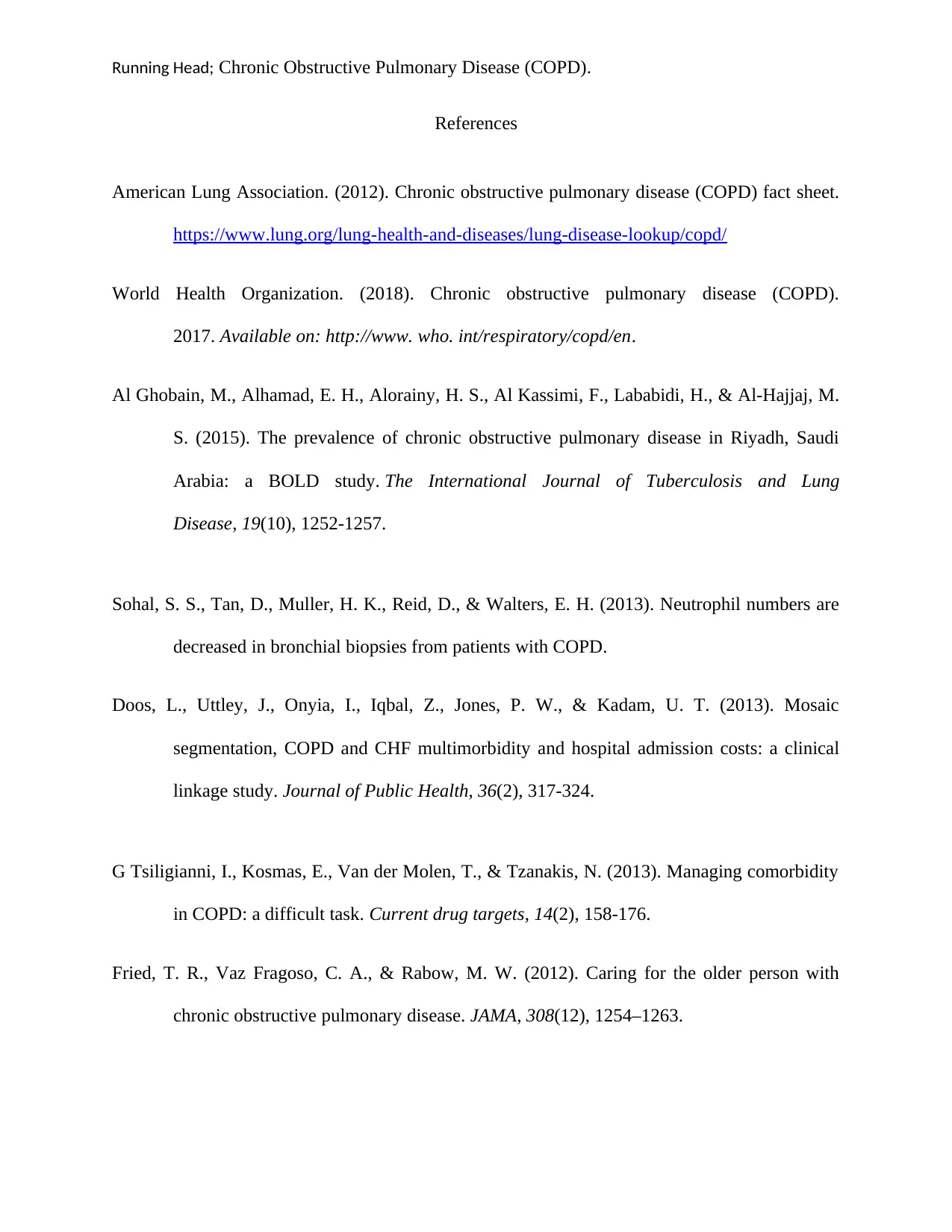
Running Head; Chronic Obstructive Pulmonary Disease (COPD).
References
American Lung Association. (2012). Chronic obstructive pulmonary disease (COPD) fact sheet.
https://www.lung.org/lung-health-and-diseases/lung-disease-lookup/copd/
World Health Organization. (2018). Chronic obstructive pulmonary disease (COPD).
2017. Available on: http://www. who. int/respiratory/copd/en.
Al Ghobain, M., Alhamad, E. H., Alorainy, H. S., Al Kassimi, F., Lababidi, H., & Al-Hajjaj, M.
S. (2015). The prevalence of chronic obstructive pulmonary disease in Riyadh, Saudi
Arabia: a BOLD study. The International Journal of Tuberculosis and Lung
Disease, 19(10), 1252-1257.
Sohal, S. S., Tan, D., Muller, H. K., Reid, D., & Walters, E. H. (2013). Neutrophil numbers are
decreased in bronchial biopsies from patients with COPD.
Doos, L., Uttley, J., Onyia, I., Iqbal, Z., Jones, P. W., & Kadam, U. T. (2013). Mosaic
segmentation, COPD and CHF multimorbidity and hospital admission costs: a clinical
linkage study. Journal of Public Health, 36(2), 317-324.
G Tsiligianni, I., Kosmas, E., Van der Molen, T., & Tzanakis, N. (2013). Managing comorbidity
in COPD: a difficult task. Current drug targets, 14(2), 158-176.
Fried, T. R., Vaz Fragoso, C. A., & Rabow, M. W. (2012). Caring for the older person with
chronic obstructive pulmonary disease. JAMA, 308(12), 1254–1263.
References
American Lung Association. (2012). Chronic obstructive pulmonary disease (COPD) fact sheet.
https://www.lung.org/lung-health-and-diseases/lung-disease-lookup/copd/
World Health Organization. (2018). Chronic obstructive pulmonary disease (COPD).
2017. Available on: http://www. who. int/respiratory/copd/en.
Al Ghobain, M., Alhamad, E. H., Alorainy, H. S., Al Kassimi, F., Lababidi, H., & Al-Hajjaj, M.
S. (2015). The prevalence of chronic obstructive pulmonary disease in Riyadh, Saudi
Arabia: a BOLD study. The International Journal of Tuberculosis and Lung
Disease, 19(10), 1252-1257.
Sohal, S. S., Tan, D., Muller, H. K., Reid, D., & Walters, E. H. (2013). Neutrophil numbers are
decreased in bronchial biopsies from patients with COPD.
Doos, L., Uttley, J., Onyia, I., Iqbal, Z., Jones, P. W., & Kadam, U. T. (2013). Mosaic
segmentation, COPD and CHF multimorbidity and hospital admission costs: a clinical
linkage study. Journal of Public Health, 36(2), 317-324.
G Tsiligianni, I., Kosmas, E., Van der Molen, T., & Tzanakis, N. (2013). Managing comorbidity
in COPD: a difficult task. Current drug targets, 14(2), 158-176.
Fried, T. R., Vaz Fragoso, C. A., & Rabow, M. W. (2012). Caring for the older person with
chronic obstructive pulmonary disease. JAMA, 308(12), 1254–1263.
⊘ This is a preview!⊘
Do you want full access?
Subscribe today to unlock all pages.

Trusted by 1+ million students worldwide
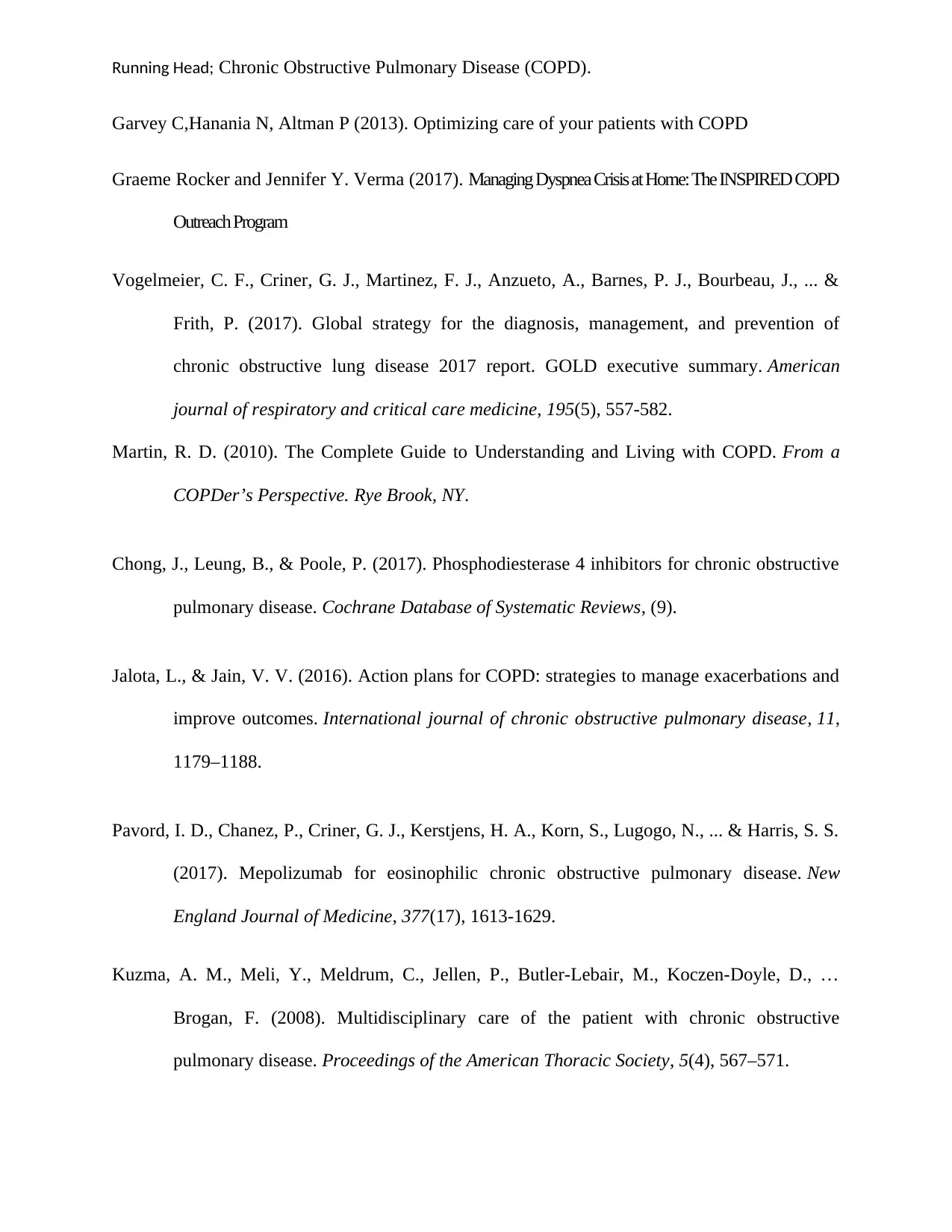
Running Head; Chronic Obstructive Pulmonary Disease (COPD).
Garvey C,Hanania N, Altman P (2013). Optimizing care of your patients with COPD
Graeme Rocker and Jennifer Y. Verma (2017). Managing Dyspnea Crisis at Home: The INSPIRED COPD
Outreach Program
Vogelmeier, C. F., Criner, G. J., Martinez, F. J., Anzueto, A., Barnes, P. J., Bourbeau, J., ... &
Frith, P. (2017). Global strategy for the diagnosis, management, and prevention of
chronic obstructive lung disease 2017 report. GOLD executive summary. American
journal of respiratory and critical care medicine, 195(5), 557-582.
Martin, R. D. (2010). The Complete Guide to Understanding and Living with COPD. From a
COPDer’s Perspective. Rye Brook, NY.
Chong, J., Leung, B., & Poole, P. (2017). Phosphodiesterase 4 inhibitors for chronic obstructive
pulmonary disease. Cochrane Database of Systematic Reviews, (9).
Jalota, L., & Jain, V. V. (2016). Action plans for COPD: strategies to manage exacerbations and
improve outcomes. International journal of chronic obstructive pulmonary disease, 11,
1179–1188.
Pavord, I. D., Chanez, P., Criner, G. J., Kerstjens, H. A., Korn, S., Lugogo, N., ... & Harris, S. S.
(2017). Mepolizumab for eosinophilic chronic obstructive pulmonary disease. New
England Journal of Medicine, 377(17), 1613-1629.
Kuzma, A. M., Meli, Y., Meldrum, C., Jellen, P., Butler-Lebair, M., Koczen-Doyle, D., …
Brogan, F. (2008). Multidisciplinary care of the patient with chronic obstructive
pulmonary disease. Proceedings of the American Thoracic Society, 5(4), 567–571.
Garvey C,Hanania N, Altman P (2013). Optimizing care of your patients with COPD
Graeme Rocker and Jennifer Y. Verma (2017). Managing Dyspnea Crisis at Home: The INSPIRED COPD
Outreach Program
Vogelmeier, C. F., Criner, G. J., Martinez, F. J., Anzueto, A., Barnes, P. J., Bourbeau, J., ... &
Frith, P. (2017). Global strategy for the diagnosis, management, and prevention of
chronic obstructive lung disease 2017 report. GOLD executive summary. American
journal of respiratory and critical care medicine, 195(5), 557-582.
Martin, R. D. (2010). The Complete Guide to Understanding and Living with COPD. From a
COPDer’s Perspective. Rye Brook, NY.
Chong, J., Leung, B., & Poole, P. (2017). Phosphodiesterase 4 inhibitors for chronic obstructive
pulmonary disease. Cochrane Database of Systematic Reviews, (9).
Jalota, L., & Jain, V. V. (2016). Action plans for COPD: strategies to manage exacerbations and
improve outcomes. International journal of chronic obstructive pulmonary disease, 11,
1179–1188.
Pavord, I. D., Chanez, P., Criner, G. J., Kerstjens, H. A., Korn, S., Lugogo, N., ... & Harris, S. S.
(2017). Mepolizumab for eosinophilic chronic obstructive pulmonary disease. New
England Journal of Medicine, 377(17), 1613-1629.
Kuzma, A. M., Meli, Y., Meldrum, C., Jellen, P., Butler-Lebair, M., Koczen-Doyle, D., …
Brogan, F. (2008). Multidisciplinary care of the patient with chronic obstructive
pulmonary disease. Proceedings of the American Thoracic Society, 5(4), 567–571.
Paraphrase This Document
Need a fresh take? Get an instant paraphrase of this document with our AI Paraphraser
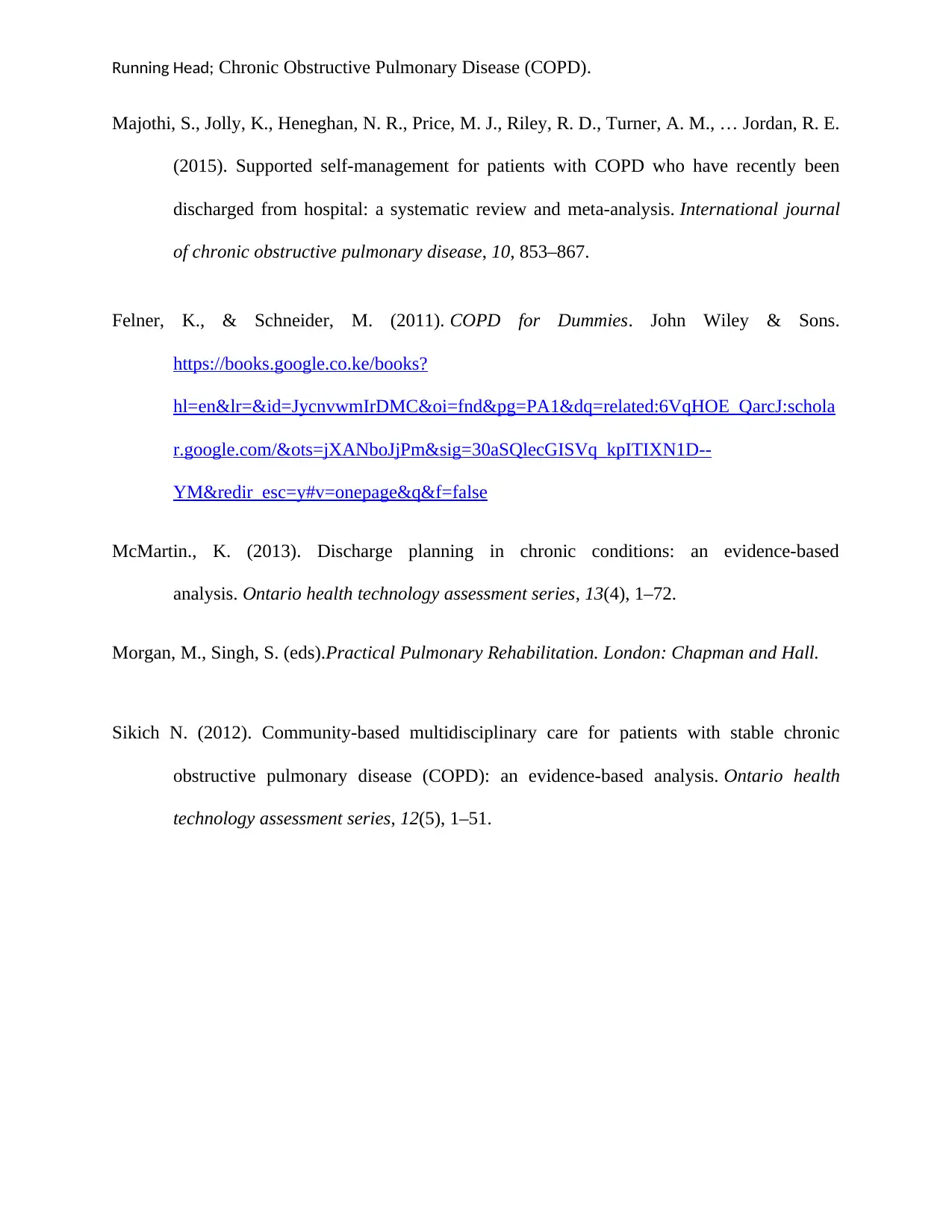
Running Head; Chronic Obstructive Pulmonary Disease (COPD).
Majothi, S., Jolly, K., Heneghan, N. R., Price, M. J., Riley, R. D., Turner, A. M., … Jordan, R. E.
(2015). Supported self-management for patients with COPD who have recently been
discharged from hospital: a systematic review and meta-analysis. International journal
of chronic obstructive pulmonary disease, 10, 853–867.
Felner, K., & Schneider, M. (2011). COPD for Dummies. John Wiley & Sons.
https://books.google.co.ke/books?
hl=en&lr=&id=JycnvwmIrDMC&oi=fnd&pg=PA1&dq=related:6VqHOE_QarcJ:schola
r.google.com/&ots=jXANboJjPm&sig=30aSQlecGISVq_kpITIXN1D--
YM&redir_esc=y#v=onepage&q&f=false
McMartin., K. (2013). Discharge planning in chronic conditions: an evidence-based
analysis. Ontario health technology assessment series, 13(4), 1–72.
Morgan, M., Singh, S. (eds).Practical Pulmonary Rehabilitation. London: Chapman and Hall.
Sikich N. (2012). Community-based multidisciplinary care for patients with stable chronic
obstructive pulmonary disease (COPD): an evidence-based analysis. Ontario health
technology assessment series, 12(5), 1–51.
Majothi, S., Jolly, K., Heneghan, N. R., Price, M. J., Riley, R. D., Turner, A. M., … Jordan, R. E.
(2015). Supported self-management for patients with COPD who have recently been
discharged from hospital: a systematic review and meta-analysis. International journal
of chronic obstructive pulmonary disease, 10, 853–867.
Felner, K., & Schneider, M. (2011). COPD for Dummies. John Wiley & Sons.
https://books.google.co.ke/books?
hl=en&lr=&id=JycnvwmIrDMC&oi=fnd&pg=PA1&dq=related:6VqHOE_QarcJ:schola
r.google.com/&ots=jXANboJjPm&sig=30aSQlecGISVq_kpITIXN1D--
YM&redir_esc=y#v=onepage&q&f=false
McMartin., K. (2013). Discharge planning in chronic conditions: an evidence-based
analysis. Ontario health technology assessment series, 13(4), 1–72.
Morgan, M., Singh, S. (eds).Practical Pulmonary Rehabilitation. London: Chapman and Hall.
Sikich N. (2012). Community-based multidisciplinary care for patients with stable chronic
obstructive pulmonary disease (COPD): an evidence-based analysis. Ontario health
technology assessment series, 12(5), 1–51.
1 out of 11
Related Documents
Your All-in-One AI-Powered Toolkit for Academic Success.
+13062052269
info@desklib.com
Available 24*7 on WhatsApp / Email
![[object Object]](/_next/static/media/star-bottom.7253800d.svg)
Unlock your academic potential
Copyright © 2020–2025 A2Z Services. All Rights Reserved. Developed and managed by ZUCOL.




